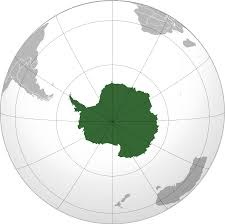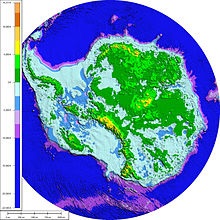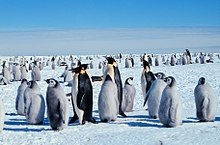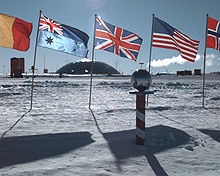|
|
| |
|
|
| |
|
|
|
|
| |
 |
| Map showing location
of Antarctica. |
Antarctica
Antarctica is the Earth's southernmost continent. It is
on the South Pole. It's almost entirely south of the
Antarctic Circle. Around Antarctica is the Southern
Ocean. At 14.0 million km2 (5.4 million sq mi), it is
the fifth-largest continent in area after Asia, Africa,
North America, and South America. About 98% of
Antarctica is covered by ice. This ice averages at least
1.6 kilometers (1.0 mi) in thickness.
Antarctica, on average, is the coldest, driest, and
windiest continent. It is also the highest of all the
continents. Antarctica is considered a desert. It has
yearly precipitation of only 200 mm (8 inches) near the
sea and far less inland. No humans live in Antarctica
permanently. However, about 1,000 to 5,000 people live
through the year at the science stations in Antarctica.
Only plants and animals that can live in cold live
there. The animals include penguins, seals, nematodes,
tardigrades and mites. Plant life includes some grass
and shrubs, algae, lichen, fungi, and bacteria.
The first known sighting of the continent was in 1820.
Antarctica was mostly forgotten for the rest of the 19th
century. This was because of its hostile environment,
few resources, and isolation. The first official use of
the name Antarctica as a continental name in the 1890s
is said to have been used by Scottish cartographer John
George Bartholomew.
The Antarctic Treaty was signed in 1959 by 12 countries.
More countries have signed the treaty since then. So
far, 46 countries have signed the treaty. The treaty
declares that military activities and mineral mining are
against the law. However, it supports scientific
research. It also helps the continent's ecozone. More
than 4,000 scientists from different nations and
different interests experiment together. |
|
 |
| Subglacial
topography and bathymetry of bedrock underlying
Antarctica ice sheet. |
Geography and geology
Antarctica is covered by an ice sheet about four
kilometres thick. Under the ice it is mostly land,
although the ice shelves are over the ocean. The
Transantarctic Mountains divide the land between East
Antarctica in the Eastern Hemisphere and West Antarctica
in the Western Hemisphere.
Antarctica has some important features hidden by the
ice. One is Lake Vostok, which has been covered by ice
for at least 15 million years. The lake is 250 km long
and 50 km wide. Another is the huge Gamburtsev mountain
chain, which are the size of the Alps, yet entirely
buried under the ice. The Gamburtsev range has a nearby
massive rift valley similar to the East African Great
Rift Valley. It is called the Lambert system. Scientists
used radar that can work under ice to survey the whole
of Antarctica.
Climate
Antarctica is the coldest of Earth's continents. It used
to be ice-free until about 34 million years ago, when it
became covered with ice. The coldest natural air
temperature ever recorded on Earth was −89.2 °C (−128.6
°F) at the Soviet (now Russian) Vostok Station in
Antarctica on 21 July 1983.
Antarctica is a frozen desert with little rain; the
South Pole itself receives less than 10 cm (4 in) per
year, on average. Temperatures reach a minimum of
between −80 °C (−112 °F) and −89.2 °C (−128.6 °F) in the
interior in winter and reach a maximum of between 5 °C
(41 °F) and 15 °C (59 °F) near the coast in summer.
Sunburn is often a health issue as the snow surface
reflects almost all of the ultraviolet light falling on
it. Given the latitude, long periods of constant
darkness or constant sunlight create climates unfamiliar
to human beings in much of the rest of the world.
East Antarctica is colder than its western counterpart
because of its higher elevation. Weather fronts rarely
penetrate far into the continent, leaving the centre
cold and dry. Despite the lack of rain over the central
portion of the continent, ice there lasts for extended
periods. Heavy snowfalls are common on the coastal
portion of the continent, where snowfalls of up to 1.22
metres (48 in) in 48 hours have been recorded.
At the edge of the continent, strong katabatic winds off
the polar plateau often blow at storm force. In the
interior, wind speeds are typically moderate. During
clear days in summer, more solar radiation reaches the
surface at the South Pole than at the equator because of
the 24 hours of sunlight each day at the Pole.
Antarctica is colder than the Arctic for three reasons.
First, much of the continent is more than 3,000 m (9,800
ft) above sea level, and temperature decreases with
elevation in the troposphere. Second, the Arctic Ocean
covers the north polar zone: the ocean's relative warmth
is transferred through the icepack and prevents
temperatures in the Arctic regions from reaching the
extremes typical of the land surface of Antarctica.
Third, the Earth is at aphelion in July (i.e., the Earth
is farthest from the Sun in the Antarctic winter), and
the Earth is at perihelion in January (i.e., the Earth
is closest to the Sun in the Antarctic summer). The
orbital distance contributes to a colder Antarctic
winter (and a warmer Antarctic summer) but the first two
effects have more impact.
The aurora australis, commonly known as the southern
lights, is a glow observed in the night sky near the
South Pole created by the plasma-full solar winds that
pass by the Earth. Another unique spectacle is diamond
dust, a ground-level cloud composed of tiny ice
crystals. It generally forms under otherwise clear or
nearly clear skies, so people sometimes also refer to it
as clear-sky precipitation. A sun dog, a frequent
atmospheric optical phenomenon, is a bright "spot"
beside the true sun. |
|
 |
| Emperor penguins
with juveniles. |
Life in Antarctica
Plants
Few land plants grow in Antarctica. This is because
Antarctica does not have much moisture (water),
sunlight, good soil, or a warm temperature. Plants
usually only grow for a few weeks in the summer.
However, moss, lichen and algae do grow. The most
important organisms in Antarctica are the plankton which
grow in the ocean.
Animals
One important source of food in the Antarctic is the
krill, which is a general term for the small shrimp-like
marine crustaceans. Krill are near the bottom of the
food chain: they feed on phytoplankton and to a lesser
extent zooplankton. Krill are a food form suitable for
the larger animals for whom krill makes up the largest
part of their diet. So whales, penguins, seals, and even
some of the birds that live in the Antarctic, depend on
krill.
Whales are the largest animals in the ocean, and in
Antarctica. They are mammals, not fish. That means that
they breathe air and do not lay eggs. Many different
kinds of whales live in the oceans around Antarctica.
Whalers have hunted whales for hundreds of years, for
meat and blubber. Nowadays most whaling is done in the
Antarctic area.
Penguins only live south of the equator. Several
different kinds live in and around Antarctica. The
biggest ones can stand nearly 4 feet (1.2m) tall and can
weigh almost 100 pounds (40 kg). The smallest kinds are
only about one foot (30 cm) tall. Penguins are large
birds that swim very well but cannot fly. They have
black backs and wings with white fronts. The penguins
have a thick layer of blubber that keeps them warm.
Their feathers are very tightly packed and they are on
top of each other to make another thick cover. They also
have a layer of woolly down under the feathers. The
feathers themselves are coated with a type of oil that
makes them waterproof. The penguins eat fish and are at
home in the ocean. They come up on the land or ice to
lay their eggs and raise the chicks. The animals nest
together in a huge group. |
|
 |
| The "ceremonial"
South Pole, at Amundsen–Scott Station. |
History of its discovery
For a long time, people had believed that there was a
great continent in the far south of Earth. They thought
this Terra Australis would "balance" the lands in the
north like Europe, Asia and North Africa. People have
believed this from the times of Ptolemy (1st century
AD). He suggested this idea to keep the balance of all
known lands in the world. Pictures of a large land in
the south were common in maps. In the late 17th century,
people discovered that South America and Australia were
not part of the mythical "Antarctica". However,
geographers still believed that Antarctica was much
bigger than it really was.
European maps continued to show this unknown land until
Captain James Cook's ships, HMS Resolution and
Adventure, crossed the Antarctic Circle on 17 January
1773, in December 1773. They crossed it again in January
1774. In fact, Cook did come within about 75 miles (121
km) of the Antarctic coast. However, he was forced to go
back because of ice in January 1773.
The first confirmed sighting of Antarctica were by three
different men. According to different organizations,
ships captained by three men saw Antarctica in 1820. The
three men were Fabian von Bellingshausen (a captain in
the Russian Imperial Navy), Edward Bransfield (a captain
in the Royal Navy), and Nathaniel Palmer (an American
seal hunter out of Stonington, Connecticut). The first
recorded landing on mainland Antarctica was by the
American sealer John Davis. He landed on West Antarctica
on 7 February 1821. However, some historians are not
sure about this claim.
People began discovering different parts of Antarctica
and mapping them. This was slow work because they could
only work in the summer. At last a map was made, and
people began to talk about exploring the land, not only
the sea. However, this would have been very hard work.
They would have to break through the ice that was around
Antarctica. Then they would have to land on it and bring
in enough things to live on while they explored the
land.
The first serious exploration of the Antarctic land was
the Nimrod Expedition led by Ernest Shackleton in
1907–09. They were the first to climb Mount Erebus and
to reach the South Magnetic Pole. Shackleton himself and
three other members of his expedition made several
firsts in December 1908 – February 1909. They were the
first humans to cross the Ross Ice Shelf, and the
Transantarctic Mountain Range (via the Beardmore
Glacier). They were the first to set foot on the South
Polar Plateau.
Robert Falcon Scott, the most well known of all of the
explorers, wanted to be the first man to reach the South
Pole. At the same time, another team from Norway lead by
Roald Amundsen started. They both raced each other to
the South Pole, but in the end Amundsen won because he
had made a good use of his sleigh dogs. Scott had used
ponies and motor sleds, but when he got to the South
Pole he found a message from Amundsen, showing that he
had beaten Scott.
On his way back, Scott and three companions met a
blizzard and froze to death while waiting for it to
finish. The people who found him eight months later also
found his records and diary, which he had written to the
day he died.
Climate change and global warming are showing effects in
Antarctica, particularly the Antarctic Peninsula.
People
People of the Antarctic live in there for a short time
to learn more about Antarctica, so most of the people
who live there are scientists. Most are in national
science stations on the coast. Some bases are far from
the sea, for example at the South pole. They study the
weather, animals, glaciers, and the earth's atmosphere.
Some scientists drill ice cores to find out about the
weather long ago. People who work in the Antarctic must
be careful, because a blizzard can start any time and
any where. When they go far away from their shelter,
they must always take lots of food just in case.
Today people explore Antarctica using snowmobiles, which
are faster than dogs and can pull heavier loads. Many
come to Antarctica just for a short visit, as a trip.
There are companies in South America that have vacations
to Antarctica, so people pay to go there in a ship. Some
people may just take their own boats. |
|
|
 Kiddle: Antarctica Kiddle: Antarctica
Wikipedia: Antarctica |
|
|
|
|
|
|
|
|
|
|
|
|
|
|
|
|
Search Fun Easy English |
|
|
|
|
|
|
|
|
|
|
|
|
|
|
|
About
Contact
Copyright
Resources
Site Map |